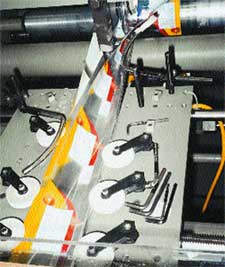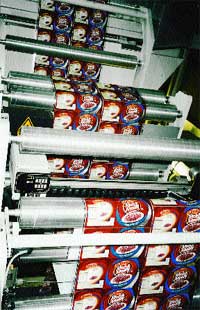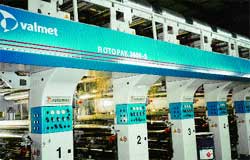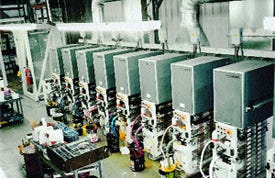Looking better with shrink-sleeve labels
|
A 10-color gravure press runs numerous labels, such as those for Hellmann's mayonnaise and Ragu sauces. |
Founded in 1998 as a pure flexographic house, Coastal Sleeve Label (CSL) has expanded into gravure-printed labels as well, and now produces flexo and gravure shrink-sleeve labels, and flexo stretch-sleeve labels. Unilever Bestfoods became one of CSL's largest customers in early '02, when the giant international food processing company decided to convert from pressure-sensitive labels to shrink sleeves for many of its most prominent products. In many cases, Unilever Bestfoods retained the same bottles, and just changed the labels.
"We're a partner with Unilever Bestfoods. We provided technical support in their move into stretch-sleeve labels," says CSL president Charles Werk. "They developed the initial label designs, and then CSL conducted preliminary tests and developed the final material specifications."
Says Gail Young, senior manager, print production at Unilever Bestfoods' Visual Branding Center, "With the 360-degree graphics and 100-percent print coverage, the shrink-sleeve labels are beautiful. CSL has done an excellent job for us. We are very impressed with the quality of the labels they are printing for a number of our products, and they have been very responsive to our needs."
At the time of PD's visit, CSL was printing flexo and gravure shrink-sleeve labels for different sizes and varieties of mayonnaise, Dijon mustard, Ragu sauces, and Bertolli pesto sauces, on a number of different presses.
Ten-color gravure press runs 40-in.-wide film
One of the main systems at CSL is a Rotomec Model Rotopak 3000-5 10-color gravure press from Valmet Converting. The unit, which can run 40-in.-wide films at speeds to 725 ft/min, produces labels for Unilever Bestfoods' flavored mayonnaise and Ragu sauces. To start this operation, a roll of film is mounted on the unwind unit, from which it passes over a dancer roll and through an edge-guide and infeed draw-group, into the printing press section.
The machine is equipped with an auto-splice system that splices the trailing edge of the old (running) roll onto a new roll at full speed. In this process, the operator fastens a piece of two-sided tape onto the width of the new roll, which is mounted beside the running roll. When the splice is to be made, the new roll is moved into running position, and its speed is matched to the machine's speed. The web from the new roll is then pushed against the running roll to attach it. An interesting feature of this system is that a new roll can be spliced onto the running roll at any time. It doesn't have to wait until the end of the running roll. For example, the system can be set to splice the new roll after a set number of feet of film has run off the old roll. Or, it can be set to automatically make the splice when the old roll runs out, without operator intervention.
|
The 10-color gravure press incorporates sophisticated control and inspection systems, including a register control and a web inspection system with a 17-fold zoom lens. |
In the printing press section, the film passes over individual print cylinders that apply the ink onto engraved cylinders. These transfer the ink onto the film. A Teflon bar mounted about 1 mm under each engraved cylinder provides a dam that forces the ink into the gravure cells, after which a doctor blade removes excess ink. The ink pump at each station has a dual filter with a 100-micron screen and a magnet to remove any metal particles. The operator switches from one filter to the other by turning a handle.
With the unit's quick-change design, print cylinders can be changed in 30 sec. The new print cylinder is mounted onto a trolley for transport to the press. The old print cylinder is removed, and the new cylinder is slid into place. It is also possible to prepare unused printing units while the machine is running.
After transferring the ink image onto the film, the web is pulled up through a vertical dryer. Dryers on all but the first and last stations are single-sided. On the first and last stations, the dryers are double-sided to accommodate heavier laydowns of ink. For example, the plant could cover the entire web with a full coat of ink in the first station, and it could apply a full coat of lacquer at the last station.
A single, centralized system supplies air to all of the dryers. The air is recirculated until it reaches the preset solvent concentration level, at which point some of the air is exhausted and replaced with fresh air. Automatic controls adjust the exhaust and replenishment levels to maintain the solvent concentration at safe limits. The air system incorporates safeguards as specified by the National Electric Code (NEC), and the entire press is classified as explosion-proof in accord with NEC Class I-Divisions I and II.

As the web leaves each dryer, it wraps over a chill roll that cools the film. Each print station maintains preset tension to the film, but the main tension comes from the outfeed draw-group located after the last printing station. Film leaving this draw-group is wound onto a core at the rewind station, which has the same full-speed splicing capabilities as the unwind station.
The press is equipped with Siemens PLC 7 controls, AC Vector drives and Profibus connection for I/O, drives and auxiliary equipment. The machine incorporates full digital control, and a machine-mounted operator panel, to manage recipes, alarms and machine parameters, including a 24-hr rolling history of all parameters. The press also includes a modem interface that enables Valmet service technicians to access data by phone lines, and make operating changes remotely.
The press is also equipped with an Eltromat DGC 650 register control and a Web Video 2001 web-inspection system, from Eltromat Electronics, the latter of which is mounted with the other instrumentation in the main control cabinet at the operating station. Along with conventional web/cylinder and two-channel web/web measurement, the DG 650 provides a unique single-head web/web measure function for register marks. Patented by Eltromat, this type of measurement ensures simple handling for fixed selection of sequential or key color control, automatically providing a unique combination of both types of control procedures.
Acceleration and deceleration of the printing press create tension instability, leading to register deviation and waste. The intelligent algorithms of the patented automatic speed-control function continuously adapt the control parameters to the current machine mode, ensuring optimum register control. The system detects off-register deviations, such as those caused by reel changes, splices or incompletely printed register marks, and the unit's automatic-jump error function automatically adapts the register control to ignore these. A special printed code allows the DGC 650 to automatically set the gates for measuring the register marks. This reduces setup time and waste.
The Web Video 2001 inspection system is centrally controlled by a touch control panel and joysticks. The menu-guided operation enables easy handling of the display, and clearly arranged symbol keys allow quick access to all important system functions. The high-resolution three-chip camera is mounted at the end of the press where it inspects the exiting film and enables the operator to see the true condition of the printed web. A light-intensive and progressively adjustable 17-fold zoom lens allows a distortion-free presentation of the web in various magnifications. Automatic presetting of zoom and iris guarantees consistent repeatability of the printing areas to be inspected.
Strobe tubes provide an absolute homogeneous illumination of the image, which is transmitted to a 100-Hz monitor that allows inspection of the web at different positions. The printed pattern is displayed with a faded-in master image of any size. During production, even the smallest deviations from the printed pattern are visible to the operator. The system automatically compares the "live" picture with the corresponding master, and sounds an alarm if there is any deviation.
As a full-service shrink-sleeve label producer, CSL maintains a full range of supporting equipment. This includes a solventless laminator from Uteco that laminates clear film over printed film to protect the printing, and Uteco slitters that cut the six-wide film from the press into separate rolls.
 The plant also has seamers from DCM that form the tubes of labels. The machine applies a 3- to 4-mL bead of tetrahydrofuran solvent to one edge of the film, which then travels over rollers and a plow that overlaps the two edges to form the finished tube of material. The tube is rolled onto a cardboard core that oscillates slightly side-to-side so that the material lays flat and does not form the raised area that would result if the double layer of the seam was rolled on top of itself.
The plant also has seamers from DCM that form the tubes of labels. The machine applies a 3- to 4-mL bead of tetrahydrofuran solvent to one edge of the film, which then travels over rollers and a plow that overlaps the two edges to form the finished tube of material. The tube is rolled onto a cardboard core that oscillates slightly side-to-side so that the material lays flat and does not form the raised area that would result if the double layer of the seam was rolled on top of itself.
Label film is a 2-mil, high-shrink polyvinyl chloride, supplied by Bonset America.
More information is available:
Label converting: Coastal Sleeve Label, Inc., 912/466-9556. Circle No. 268.
Press: Valmet Converting, a member of Metso Converting, 704/587-2265. Circle No. 262.
Controls: Siemens Energy & Automation, Inc., 770/740-3000. Circle No. 263.
Controls, inspection system: Eltromat Electronics, Inc., 757/487-8849. Circle No. 264.
Laminator, slitter, press: Uteco, 770/427-4100. Circle No. 265.
Seamer: DCM, 33 141 375270. Circle No. 266.
Film: Bonset America Corp., 336/375-0234. Circle No. 267.
Flexo and gravure presses provide options | ||
In addition to the Rotomec press, CSL has several other presses running Unilever labels. These include a Chromas Technologies' AquaTech nine-color flexo press that was printing labels for Dijon mustard during PD's visit, a Uteco eight-color central-impression flexo press, and a Chesnut Engineering Supra 1900 nine-color gravure press that was running labels for Bertolli pesto sauce during PD's visit.
Of these, the Chesnut press, which was installed less than a year ago, is the newest. Aimed at short production runs of up to 30,000 sq m/copy order, the quick-changeover unit can run as many as five different labels in a day. The Supra 1900 runs up to a 24-in.-wide web width with a 24-in. repeat length at speeds to 750 ft/min. On-press changeovers can be accomplished using only a two-man operating crew in five- to 10-min per color. |
About the Author(s)
You May Also Like





